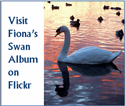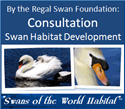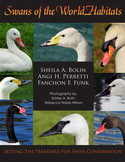Ask the Swan Specialist
Date: 10 January 2014
Hi Kim:
There are no guarantees that either swan will accept each other. If they do not, one or both could be seriously hurt or even killed. You will need to build a pen (enclosed top to bottom to ensure predators cannot dig under or climb over into the pen. The pen needs to be 1/2 in the water and 1/2 on land with a feeder inside. The new swan will need to be housed for approximately 2 weeks in the pen to ensure that there is no aggressive behavior and allow it time to acclimate to you, the other swan and the new habitat. Even then, after releasing the male onto the pond, you need to have a rescue boat on standby in the event aggression takes place and one or both swans are injured.
The most important issue is to ensure that you in fact have a female swan before even beginning to make an introduction of another swan to the habitat. If you are not sure, the swan needs to be examined by a licensed veterinarian experienced in swans or waterfowl. If you were to place a same gendered swan onto the pond, the swans could seriously injure or kill each other because older birds will not pair with the same gendered bird. This only works when the swans are very young and are raised together. Again, there are still no guarantees that even young swans will pair with another swan.
Now, having said all of this, the above issues are the least of your community's concern. Many states are now following the ill-directed federal mandate to cull (kill) Mute Swans because they were intentionally removed from the Federal Migratory Act so that they could be killed. The object is to kill 130,000 in the next few years to supposedly bring back the Trumpeter Swan which is the largest of all waterfowl and the largest of the swan species. Eventually, the Trumpeter Swan will be seen as a Trophy Waterfowl and permits to make wildlife coffers money, will be issued to hunt and kill the Trumpeters as a Trophy Waterfowl.
So, what does this mean to you and your community. Your swan may be grandfathered in (you may or may not need a permit for possession, but you need to check on this). Just know that this may place your swan on the culling block or require you to procure a license for possession.
If you do not need a permit for the remaining swan (grandfathered in), you may need a permit for the new swan. If you introduce an opposite gendered swan, you may be subject to a breeder's license as the swans can now produce offspring. Mute Swans produce one brood a year for 30 years during their lifetime and can produce 1-13 cygnets a year. All cygnets produced by your pair must be pinioned (rendered unable to fly at 1-3 weeks of age). This requires the services of the licensed veterinarian to conduct the procedure. If the swans are allowed to fly, your community can be assessed up to $500 per flying bird. The state (if this pertains to your state) can shoot the bird out of the sky and charge you for the bullet and the manpower in preventing a feral population. Bottom line: YOU must have the cygnets pinioned.
At 8-10 months of age, the pond is going to get very small with all of the cygnets from year to year and their parents. The parents will aggressively chase the young birds off the pond to begin the breeding process again. The cygnets can be seriously injured, killed or begin to wander and look for other areas as they cannot fly, so the young swans may wander into areas of traffic, domesticated dogs and cats or wildlife areas where they cannot protect themselves.
Once the cygnets reach 2 years of age, they are capable of producing young. With all of these swans, your community will be required to find the birds a humane and safe habitat elsewhere. If you cannot find the cygnets a good home, you will be responsible for each swan, their veterinary care and daily upkeep.
As you can see, this is probably not the road that your community wants to take. We have seen this same scenario many times and there are no guarantees that anything will work and can actually create worse problems. Sometimes, leaving well enough alone is the answer.
We would strongly suggest that a new swan not be placed in this habitat. Swans can live their lives alone with no ill effects. If you feel that the swan needs company, we would suggest some ornamental geese or ducks. Again, the swan may feel threatened even with these new pals and may try to chase them from the area. Many times, humans place human feelings with wildlife and wildlife do not necessarily share these feelings. This human intervention can eventually cause wildlife injury or demise. We hope that this information is of benefit to you. The Regal Swan
Messages In This Thread
- Introducing another Mute Swan -- Kim -- 9 January 2014
- Re: Introducing another Mute Swan -- The Regal Swan -- 10 January 2014
- Re: Introducing another Mute Swan -- Kim -- 10 January 2014
- Re: Introducing another Mute Swan -- The Regal Swan -- 10 January 2014
- Re: Introducing another Mute Swan -- Kim -- 10 January 2014
- Re: Introducing another Mute Swan -- The Regal Swan -- 10 January 2014
Ask the Swan Specialist is powered by
Tetra-WebBBS 5.30 Beta © 2006-2007 Tetra-Team






